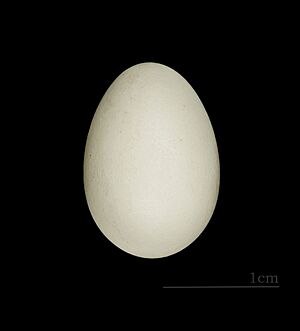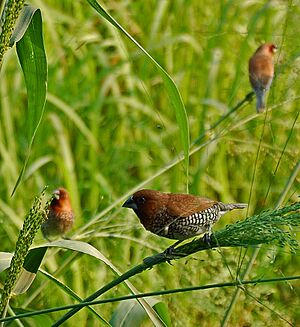Scaly-breasted munia facts for kids
Quick facts for kids Scaly-breasted munia |
|
|---|---|
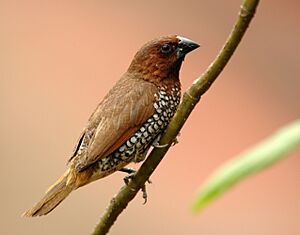 |
|
| L. p. punctulata (India) | |
| Conservation status | |
| Scientific classification | |
| Genus: |
Lonchura
|
| Species: |
punctulata
|
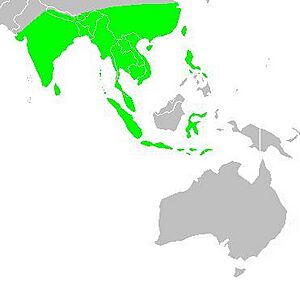 |
|
| Native range | |
| Synonyms | |
|
|
The scaly-breasted munia (Lonchura punctulata) is a small bird from tropical Asia. It is also called the spotted munia. In the pet trade, people know it as the nutmeg mannikin or spice finch. This bird is about the size of a sparrow.
The scaly-breasted munia gets its name from the special scale-like patterns on its chest and belly. Adult birds are brown on top and have a dark, cone-shaped beak. There are 11 different types, or subspecies, of this bird. They live in different places and look a little different in size and color.
These birds mostly eat grass seeds. They also munch on berries and small insects. Scaly-breasted munias often look for food in groups. They talk to each other using soft calls and whistles. They are very social birds and sometimes even sleep together with other types of munias. You can find them in warm, flat areas and grasslands. When they have babies, they build dome-shaped nests from grass or bamboo leaves.
Contents
About the Scaly-breasted Munia
The scaly-breasted munia is originally from Asia. It lives from India and Sri Lanka all the way east to Indonesia and the Philippines. In the Philippines, it is called mayang pakíng. People have also brought these birds to many other parts of the world. Now, you can find wild groups in places like Puerto Rico, Hispaniola, Australia, and the United States. The International Union for Conservation of Nature (IUCN) says this bird is of least concern. This means it is not in danger of disappearing.
How the Scaly-breasted Munia Got Its Name
In 1743, a British scientist named George Edwards drew and described the scaly-breasted munia. He called it the "Gowry Bird." Later, in 1758, the famous Swedish scientist Carl Linnaeus gave it the scientific name Loxia punctulata. He put it in the same group as crossbills.
Today, the scaly-breasted munia is in a group called Lonchura. This name was given by an English scientist, William Henry Sykes, in 1832. The name Lonchura comes from old Greek words meaning "spear-head" and "tail." The second part of its name, punctulata, is from Latin and means "spotted" or "dotted." This describes the bird's unique chest feathers.
Different Types of Scaly-breasted Munias
There are 11 recognized subspecies of the scaly-breasted munia. These different types live in various parts of the world:
- L. p. punctulata lives in northern Pakistan, India (except the northeast), Nepal, and Sri Lanka.
- L. p. subundulata is found in Bhutan, Bangladesh, northeast India, and west Myanmar.
- L. p. yunnanensis lives in southern China and north Myanmar.
- L. p. topela is found in southern Myanmar, Thailand, southeast China (including Taiwan), Laos, Cambodia, and Vietnam.
- L. p. cabanisi lives in the northern and western Philippines and northern Borneo.
- L. p. fretensis is found in the southern Malay Peninsula, Singapore, Sumatra, and Nias Islands.
- L. p. nisoria lives in southern Borneo, Java, Bali, and western Lesser Sundas.
- L. p. sumbae is found on Sumba Island in the western Lesser Sundas.
- L. p. blasii lives in central and eastern Lesser Sundas.
- L. p. baweana is found on Bawean Islands, near northeast Java.
- L. p. particeps lives on Sulawesi.
What Scaly-breasted Munias Look Like
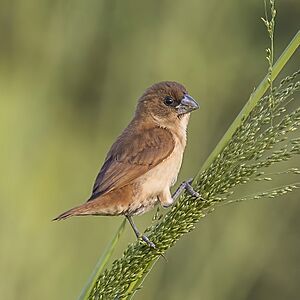
The scaly-breasted munia is about 11 to 12 centimeters (4.3 to 4.7 inches) long. It weighs about 12 to 16 grams (0.4 to 0.6 ounces). Adult birds have a short, thick, dark beak. This kind of beak is perfect for eating grains. Their upper body is brown, and their head is dark brown. Their belly is white with dark, scale-like markings. Male and female birds look similar. However, males usually have darker markings on their underside and a darker throat.
Young scaly-breasted munias look a bit different. They have pale brown upper parts and do not have the dark head of adults. Their undersides are a plain buff color. This can sometimes make them look like young birds of other munia species.
Where Scaly-breasted Munias Live

Scaly-breasted munias live in many different places. They usually stay near water and grassy areas. In India, they are very common in rice fields. Farmers sometimes see them as a small problem because they eat the grain. They mostly live in flat areas. But you can also find them in the foothills of the Himalayas, up to about 2,500 meters (8,200 feet) high. In the Nilgiris, they can be found up to 2,100 meters (6,900 feet) in summer.
Sometimes, pet birds escape from cages and start living in the wild. If the climate is right, these escaped birds can create new groups. This has happened in places like the West Indies (Puerto Rico), Hawaii, Japan, and parts of the southern United States (Florida and California).
Behavior and Life
Social Life of Munias
Scaly-breasted munias often gather in groups, sometimes with as many as 100 birds. They talk to each other with different calls. These calls include a short whistle, sounds like "kitty-kitty-kitty," and a sharp alarm sound. They sometimes flick their tails and wings up and down or side to side as they hop around. This tail flicking might help them stay together as a group. It can signal that a bird is about to fly.
When they sleep together, scaly-breasted munias sit very close to each other. The bird on the outside often tries to move closer to the middle of the group. Birds in a flock sometimes preen each other, which means they clean each other's feathers. This usually happens on the face and neck. Scaly-breasted munias are rarely mean to each other. But sometimes, they might have small arguments without any special movements.
Reproduction and Nests
The breeding season for scaly-breasted munias is usually during the summer rainy season. In India, this is mainly from June to August, and sometimes in October. Studies show that long days and high humidity help them get ready to breed. The male bird's song is very soft and hard to hear unless you are close. It sounds like a jingle, with high notes, a croaky rattle, and a slurred whistle at the end. When singing, the male sits up straight with its head feathers raised.
The nest is a large, dome-shaped structure. It is loosely woven from grass blades, bamboo, or other leaves. It has an opening on the side. They build their nests in trees or under the roofs of houses. In southern India, they like to build nests in short, bushy trees like Toddalia asiatica and Acacia chundra. The nest opening usually faces away from the strongest wind. In northern India, they prefer isolated Acacia nilotica trees in the countryside. But in city gardens, they use trees like Thuja orientalis.
Scaly-breasted munias usually lay 4 to 6 eggs, but sometimes up to 10. Both the male and female birds help build the nest and sit on the eggs. The eggs hatch in 10 to 16 days.
Food and Foraging
The scaly-breasted munia mostly eats grass seeds. They also eat small berries, like those from the Lantana plant, and tiny insects. Their beak is good for crushing small grains. Like some other munias, they might also eat algae before the breeding season. Algae is a good source of protein.
These birds are easy to keep in captivity. This makes them popular for studying how birds behave and how their bodies work. Scientists study how they find food. They look at how birds try to get the most food with the least amount of effort.
How Flock Size Helps with Food
Studies show that when scaly-breasted munias forage in larger groups, they spend less time looking out for predators. This means they have more time to find and eat food. This idea is called the "many-eyes" hypothesis. It means that in a big group, there are many eyes watching for danger. So, each bird does not have to watch as much. This allows them to focus more on finding food. Birds find seeds faster in larger groups.
Birds in a group can also help each other by "joining" others who have found food. This is like sharing information. But there is a downside to group foraging: more birds mean more competition for food. This competition can sometimes make birds focus so much on eating that they watch less for predators.
Some studies look at how birds choose between finding food themselves (being a "producer") or joining others who have found food (being a "scrounger"). When food is in clumps, scaly-breasted munias tend to be more like "scroungers." If many birds are "scrounging," it takes longer for new food patches to be found.
Conservation Status
The scaly-breasted munia is a very common bird. The IUCN Red List lists it as a species of least concern. This means it is not in danger of extinction. The bird lives in a very large area, and its population is big and stable.
In many places, people see them as a small problem for farms. This is because large groups of them eat cultivated grains like rice. In Southeast Asia, many scaly-breasted munias are caught for Buddhist ceremonies. But most of these birds are later set free.
Images for kids
-
L. p. punctulata (India)



